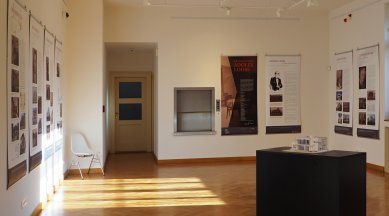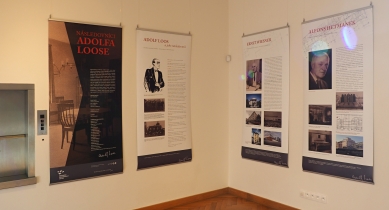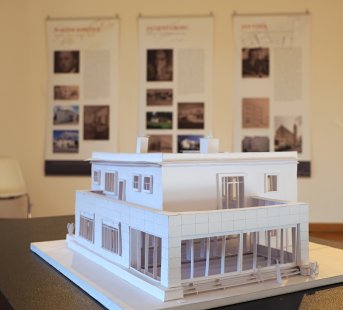
Followers of Adolf Loos - exhibition at the Stiassni villa
Source
Petr Svoboda, NPÚ, MCMA v Brně
Petr Svoboda, NPÚ, MCMA v Brně
Publisher
Tisková zpráva
12.10.2020 11:15
Tisková zpráva
12.10.2020 11:15
Czech Republic
Brno
Adolf Loos
On Friday, October 9, 2020, another exhibition commemorating the 150th anniversary of the birth of Adolf Loos was opened at the Stiassni Villa. This time it is dedicated to Loos's students and followers and their work in the territory of present-day Czech Republic. Although they were top architects, due to being either of Jewish origin or being Czech Germans or Austrians, their work was not always given due attention in the past.
On December 10, 1870, an architect was born in Brno, a promoter of modern architectural thinking, a staunch opponent of Art Nouveau ornamentalism, and a distinctive personality who has made an indelible mark in the history of architecture. A lesser-known fact is that this architect founded his own construction school in 1911, which around a hundred students attended. Most of them also worked directly in Loos's studio. After World War II, these students spread all over the world, and so we can find their creations in Europe, the USA, Israel, and New Zealand. In the Czech Republic, some of the most active were Felix Augenfeld, Jacques Groag, Alfons Hetmanek, Heinrich Kulka, Karel Lhota, or Rudolf Wels. The exhibition also presents the work of other collaborators of Adolf Loos, such as Ernst Wiesner or Jan Víšek.
The exhibition in Brno will be followed by an international symposium on November 26, featuring the most prominent global researchers dealing with the work of Adolf Loos and other architects of his time. The National Heritage Institute is also preparing a publication about Loos's followers. The book will include selected contributions from the symposium and will also be an extended version of the exhibition containing a catalog of the most significant buildings.
Due to the current measures against COVID-19, the exhibition will only be open until Sunday, October 11, 2020; its further opening depends on the development of the epidemic. However, starting Monday, October 12, the exhibition will be accessible in virtual form on the event's website.
On December 10, 1870, an architect was born in Brno, a promoter of modern architectural thinking, a staunch opponent of Art Nouveau ornamentalism, and a distinctive personality who has made an indelible mark in the history of architecture. A lesser-known fact is that this architect founded his own construction school in 1911, which around a hundred students attended. Most of them also worked directly in Loos's studio. After World War II, these students spread all over the world, and so we can find their creations in Europe, the USA, Israel, and New Zealand. In the Czech Republic, some of the most active were Felix Augenfeld, Jacques Groag, Alfons Hetmanek, Heinrich Kulka, Karel Lhota, or Rudolf Wels. The exhibition also presents the work of other collaborators of Adolf Loos, such as Ernst Wiesner or Jan Víšek.
The exhibition in Brno will be followed by an international symposium on November 26, featuring the most prominent global researchers dealing with the work of Adolf Loos and other architects of his time. The National Heritage Institute is also preparing a publication about Loos's followers. The book will include selected contributions from the symposium and will also be an extended version of the exhibition containing a catalog of the most significant buildings.
Due to the current measures against COVID-19, the exhibition will only be open until Sunday, October 11, 2020; its further opening depends on the development of the epidemic. However, starting Monday, October 12, the exhibition will be accessible in virtual form on the event's website.
The English translation is powered by AI tool. Switch to Czech to view the original text source.




0 comments
add comment











